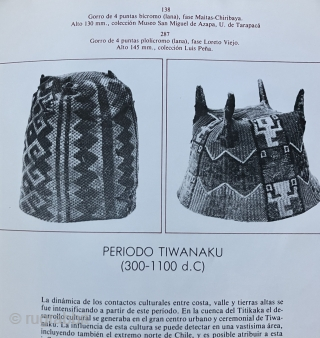Back
Exceptional and rare Pre-Columbian four cornered hat. Tiwanaku Culture, Bolivia, Chile or Peru. a.d. 600 – a.d. 900. This hat was created in a tight looping structure using fine alpaca yarns. This type of hat is attributed to the Tiwanaku Culture’s sphere of influience. The site of Tiwanaku was located in the Southern Lake Titicaca Basin of Bolivia and is one of the most impressive sites in all of the Andes. Now a unesco World Heritage Site, it was a monumental stone city constructed at an altitude of 12,500 feet above sea level. It was the highest capital in the ancient world. The influence of the Tiwanaku culture (a.d. 200 - 1100) was profound. It has been referred to by some as the “Mecca of the Andes” because of its significance as an important pilgrimage and ceremonial center during Pre-Columbian times. Hats like this are related to a well-known type of four-cornered cut pile hat made by the related Wari culture of Peru. Many of the Wari pile hats are known from collections and found in important museum collections with probably the most notable collection belonging to the Metropolitan Museum in New York. Looped hats like this one are much rarer than the Wari pile pieces and are highly desirable. The structure of these hats is completely different as they are constructed in one piece rather than several pieces like Wari hats. Tiwanaku hats are usually larger than Wari hats. The condition of this hat is remarkable as most have suffered damage or are fragmentary. This one is complete and has been professionally conserved. a similar example to this hat from a Museum in Arica, Chile (pictured in this post) also survived in good condition. The design of the two hats is very much the same and classic for the type, with stylized anthropomorphic figures and geometric motifs. The design on the top of this hat is exceptional. The many colors of the hat are subtly shaded and refined, not faded or damaged. Hats of this quality and condition rarely come to market. This has been recently acquired from an important private collection and was once in the highly regarded collection of Caroline McCoy Jones. Complete provenance is available on request. Size: 7.5 x 6 inches. The other cone shaped hat with a red top in this post is also a Tiwanaku piece. It is an early type (a.d. 300 - 700) and is available.
Ask about this
price: Contact directly - jameswblackmon@gmail.com
James Blackmon Textile Arts's pages
price:
Inquire at: jameswblackmon@gmail.com
- Home
- Antique Rugs by Region
- Category
- Profiles
- Post Items Free
- Albums
- Benaki Museum of Islamic Art
- Budapest: Ottoman Carpets
- Gulbenkian Museum
- Islamic Carpets. Brooklyn
- Islamic Textiles. Brooklyn
- Konya Museum: Rugs
- MKG, Hamburg
- MMA: Caucasian Carpets
- MMA: Mamluk Carpets
- MMA: Mughal Indian Carpets
- MMA: Ottoman Carpets
- MMA: Safavid Persian Carpets
- MMA: Turkmen Rugs
- McCoy Jones Kilims
- Ottoman textiles. Met
- Philadelphia Museum
- Rugs and Carpets: Berlin
- Seljuqs at the Met
- TIEM, Istanbul: Carpets
- V&A: Classical Carpets
- Vakiflar Carpets: Istanbul
- Baluch Rugs: Indianapolis
- Gallery Exhibitions
- Jaf an Exhibition
- Alberto Levi Gallery
- Andean Textile
- Christie's London: 2016
- Francesca Galloway
- HALI at 40
- ICOC Washington, DC 2018
- Jajims of the Shahsavan
- London Islamic Week April, 2018
- Mongolian Felts
- Navajo Rugs: JB Moore
- Persian Piled Weavings
- SF Tribal & Textile Art Show 2020
- SF Tribal 2019
- Sotheby's: C. Alexander
- Turkish Prayer Rugs
- Turkmen Main Carpets ICOC 2007














